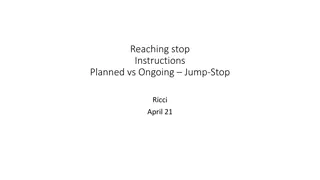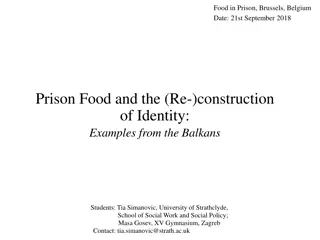The Stanford Prison Experiment
Explore the infamous Stanford Prison Experiment conducted by Phil Zimbardo, where college students were assigned roles of prisoners and guards in a simulated prison environment. Witness the rapid deterioration of behaviors and mental states, leading to the premature halt of the study. Delve into the purpose, participants, and creation of the experimental setup, shedding light on the profound psychological effects of power dynamics within a confined space.
Download Presentation

Please find below an Image/Link to download the presentation.
The content on the website is provided AS IS for your information and personal use only. It may not be sold, licensed, or shared on other websites without obtaining consent from the author.If you encounter any issues during the download, it is possible that the publisher has removed the file from their server.
You are allowed to download the files provided on this website for personal or commercial use, subject to the condition that they are used lawfully. All files are the property of their respective owners.
The content on the website is provided AS IS for your information and personal use only. It may not be sold, licensed, or shared on other websites without obtaining consent from the author.
E N D
Presentation Transcript
The Stanford Prison Experiment Adapted from Phil Zimbardo s website
Purpose of Zimbardos Experiment What happens when you put good people in an evil place? He wanted to see what the psychological effects were of becoming a prisoner or prison guard. To do this, he decided to set up a simulated prison and then carefully note the effects of this institution on the behavior of all those within its walls. His investigation had to be ended prematurely after only six days because of what the situation was doing to the college students who participated. In only a few days, the guards became sadistic and the prisoners became depressed and showed signs of extreme stress.
Participants in the Experiment More than 70 college students answered the ad in the local paper and were given diagnostic interviews and personality tests to eliminate candidates with psychological problems, medical disabilities, or a history of crime or drug abuse. Ultimately, they were left with a sample of 24 college students from the U.S. and Canada who happened to be in the Stanford area and wanted to earn $15/day by participating in a study. The study of prison life began, then, with an average group of healthy, intelligent, middle-class males.
Participants of Experiment These boys were arbitrarily divided into two groups by a flip of the coin. Half were randomly assigned to be guards, the other to be prisoners. It is important to remember that at the beginning of the experiment there were no differences between boys assigned to be a prisoner and boys assigned to be a guard. Click on the link to see the consent form given to participants: http://www.prisonexp.org/pdf/consent.pdf
Creating a Prison To closely simulate a prison environment, they called upon the services of experienced consultants, such as a former prisoner who had served nearly seventeen years behind bars. To create prison cells, they took the doors off some laboratory rooms and replaced them with specially made doors with steel bars and cell numbers.
Creating an Experimental Prison At one end of the hall was a small opening through which they could videotape and record the events that occurred. An intercom system allowed researchers to secretly bug the cells to monitor what the prisoners discussed, and also to make public announcements to the prisoners. There were no windows or clocks to judge the passage of time.
The Creation of Prisoners The prisoners were brought into the jail one at a time and greeted by the warden, who conveyed the seriousness of their offense and their new status as prisoners. Each prisoner was systematically searched and stripped naked. He was then deloused with a spray, to convey the belief that he may have germs or lice.
The Creation of Prisoners The prisoner was issued a uniform. The main part of this uniform was a dress, or smock, which each prisoner wore at all times with no underclothes. On the smock, in front and in back, was his prison ID number. On each prisoner's right ankle was a heavy chain, bolted on and worn at all times. Rubber sandals were the footwear.
The Creation of Prisoners Click on the link to see the list of rules read to the Prisoners. http://www.prisonexp.org/pdf/rules.pdf
The Creation of Guards The guards were given no specific training on how to be guards. Instead they were free, within limits, to do whatever they thought was necessary to maintain law and order in the prison and to command the respect of the prisoners. The guards made up their own set of rules, which they then carried into effect under the supervision of Warden David Jaffe, an undergraduate from Stanford University.
What happened in the Prison? Every aspect of the prisoners' behavior fell under the total and arbitrary control of the guards. Even going to the toilet became a privilege which a guard could grant or deny at his whim. Indeed, after the nightly 10:00 P.M. lights out "lock-up," prisoners were often forced to urinate or defecate in a bucket that was left in their cell. On occasion the guards would not allow prisoners to empty these buckets, and soon the prison began to smell of urine and feces -- further adding to the degrading quality of the environment.
What happened to the Prisoners?
Conclusions A Catholic priest ,who had been a prison chaplain, was invited to evaluate how realistic the prison situation was. The chaplain interviewed each prisoner individually, and half the prisoners introduced themselves by number rather than name. After some small talk, he popped the key question: "Son, what are you doing to get out of here?" When the prisoners responded with puzzlement, he explained that the only way to get out of prison was with the help of a lawyer. He then volunteered to contact their parents to get legal aid if they wanted him to, and some of the prisoners accepted his offer. Their sense of reality had shifted, and they no longer perceived their imprisonment as an experiment. In the psychological prison we had created, only the correctional staff had the power to grant paroles.
Conclusions: Guards v. Prisoners Guards Prisoners Prisoners coped with their feelings of frustration and powerlessness in a variety of ways. At first, some prisoners rebelled or fought with the guards. Four prisoners reacted by breaking down emotionally as a way to escape the situation. Others tried to cope by being good prisoners, doing everything the guards wanted them to do. The guards had won total control of the prison, and they commanded the blind obedience of each prisoner. There were three types of guards. First, there were tough but fair guards who followed prison rules. Second, there were "good guys" who did little favors for the prisoners and never punished them. And finally, about a third of the guards were hostile, arbitrary, and inventive in their forms of prisoner humiliation. These guards appeared to thoroughly enjoy the power they wielded, yet none of the preliminary personality tests were able to predict this behavior.
Conclusions On the last day, a series of debriefing sessions was held, first with all the guards, then with all the prisoners (including those who had been released earlier), and finally with the guards, prisoners, and staff together.























